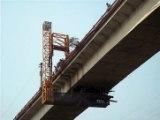Archives
BARAK BRIDGE
The allusion is to the poem by the title written by the British poet Thomas Hood in 1843. The poet has in mind the bridge in Venice of Italy that connects the Palace of Duke with the State Prison with innumerable tales, sad and sorrowful. Drawing a parallel with Venice bridge, he calls the London Bridge, also known as The Bridge of Waterloo on Thames. as “The Bridge of Sigh” reason being many unhappy and frustrated people have committed themselves with heavy sighs into the Thames. Thomas Hood in particular refers to “an ill repute girl”, unknown and unheard, who has thrown herself into the river to be lost for ever. The fallen girl in question is “beautiful, delicate and tender” but the life has been too big for her.
Apart from human tragedy, continuing problems have caused apprehensions in common and commuting people about the sustainability of the bridge located on the northern fringe of Silchar town. Public agitations from time to time have been for repair and improvement. Giving technical details of the bridge, a senior engineer of PWD (NH) division said the 472 mts long bridge has 17 spans. Out of these 12 are of 15.86 mts each, 2 of 23.48 mts each, 2 others of 56.40 mts each and the 121 mts long middle portion of the bridge stands on cantilever.
Since the construction of the bridge, some major defects were observed in the balance cantilever of 121 mts. Abnormal deflection at the tips of the cantilever arms was noticed. Central cantilever portion was repaired in 1990. After a decade, problem occurred in the central hinge portion of the cantilever that was rectified by providing a 10 mts long timber bridge over the cantilever hinged joint portion to maintain flow of traffic. Apart from that, cracks were noticed on the main cantilever arms that were repaired by expoxy grouting and by providing external stressing of the cantilever in a small portion at the support point in 1999. The condition of the bridge necessitated restriction on traffic movement, limiting it to 25 tons only, which continued to be observed more in breach than in compliance.
 Due to overloading, as pointed out by the senior engineer, all the concrete bearings of the 12 spans were damaged. Deck-slabs in all small spans also got damaged. In view of the deteriorating condition of the bridge, NH division prepared a comprehensive rehabilitation package of Rs 660.54 lakh with a recast for Rs 196.60 lakh to the Union Ministry of Surface Transport which allotted Rs 173.3 lakh to the department. The repair and rehabilitation work was assigned to the German consultancy firm Fressynet Prestressed Company.
Due to overloading, as pointed out by the senior engineer, all the concrete bearings of the 12 spans were damaged. Deck-slabs in all small spans also got damaged. In view of the deteriorating condition of the bridge, NH division prepared a comprehensive rehabilitation package of Rs 660.54 lakh with a recast for Rs 196.60 lakh to the Union Ministry of Surface Transport which allotted Rs 173.3 lakh to the department. The repair and rehabilitation work was assigned to the German consultancy firm Fressynet Prestressed Company.
The German firm started the repair and improvement work with all the modern know how and expertise. This included repair of damaged rcc component and the desk-slabs, replacement of bituminous wearing coat and preparation of asphaltic wearing coat. Replacement of damaged rcc bearing blocks with elastomeric and pot bearing, damaged expansion joint with ship seal joint, repair of beam at supports with structural strengthening with carbon fibre also formed part of the improvement work.
Along with that was carried out expoxy grouting for 12 spans and repair of handrail and painting the surface. Rehabilitation of cantilever portion in the central span with 121 mtr was done by providing external prestressing to regain the stress loss as well as the restoration of central hinge..
But, despite all the remedy, the bridge has to undergo round the year repair. With that goes on the woes and worries of people. It also remains a destination for the “frustrated and depressed”. Quite significantly, it is perhaps the only bridge in the state that was thrown open to traffic by people themselves without waiting for politicians to flag off.

